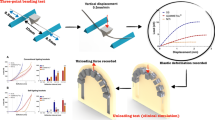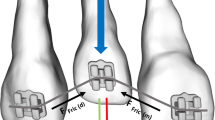Abstract
This paper presents experimental studies to examine effect of crowding stages on stress distributions on orthodontic archwire using loading tests and 2D photogrammetry technique. Three specimens representing crowding II, crowding I, and alignment stage were fabricated based on a 3D images of upper teeth. Engaged NiTi archwire is loaded with weights to induce deformation, and 2D photogrammetry technique was used to loaded wire and curvature change of the engaged wire from the captured images. Axial and flexural stresses were obtained, which were used to calculate von Mises stress distributions along the wire. The results show that the averaged von Mises stress of archwire was released in about 10% when the alignment of teeth changes from crowding II to I and crowding I to alignment. Comparing all three stages, it was common that flexural stresses were much larger than the axial stresses. In addition, the wire stresses were concentrated more on molar teeth area due to anchorage effect, regardless of crowding stage. This study shows not only how stresses were distributed along the wire but also how stress distributions on wire change as orthodontic treatment proceeded, which can be used to improve effectiveness of treatment and develop wire design.
Graphical abstract










Similar content being viewed by others
Availability of data and materials
The data and materials had been included in the manuscript.
References
Burston C, Goldberg A (1980) Beta titanium: a new orthodontic alloy. Am J Orthod 77(2):121–132
Burston C (1985) Chinese NiTi wire-a new orthodontic alloy. Am J Orthod 87(6):445–452
Fercec J, Kos M, Bruncko M, Anžel I, Glišić B, Marković E, Rudolf R (2014) Comparison of niti orthodontic archwires and a determination of the characteristic properties. Mater Tehnol Inst Met Technol 48(1):99–104
Tian M (2017) Physhologic anchorage control: a new orthodontic concept and its clinical application. Springer, pp 79–81, pp 116
Zhou X, Xia Z, Gan Y, Zhang Do, Xiong J, Fang P, Li G, Zhao Q (2016) Orthodontic force simulation of tooth-PDL-bone complex under archwire loading, conference proceedings” Annual International Conference of the IEEE Engineering in Medicine and Biology Society, 6030–6033
Zhou X, Gan Y, Zhao Q, Xiong J, Xia Z (2019) Simulation of orthodontic force of archwire applied to full dentition using virtual bracket displacement method. Int J Numer Metho Biomed Engng 35:e3189
Yang Y, Tang W (2018) Analysis of the influences of bracket and force system in different directions on the moment to force ration by finite element method. EURASIP J Wirel Commun Netw 169.https://doi.org/10.1186/s13638-018-1187-1
Jaeger R, Schmidt F, Naziris K, Lapatki BG (2021) Evaluation of orthodontic loads and wire–bracket contact configurations in a three-bracket setup: comparison of in-vitro experiments with numerical simulations. J Biomech 121(2021):110401
Kurol J, Franke P, Lundgren D, Owman-Moll P (1996) Force magnitude applied by orthodontists. N inter-and Intra-individual study. Eur J Orthod 18:69–75
Ormco Corporation. https://ormco.com/
AutoCad (2020) Autodesk, Inc., CA, USA
Ugural AC, Fenster SK (1995) Advanced strength and applied elasticity. Prince Hall Inc, New Jersey, USA, p 155
Acknowledgements
This research was supported by Basic Science Research Program through the National Research Foundation of Korea (NRF) funded by the Ministry of Education (NRF-2018R1D1A1A02085366)
Author information
Authors and Affiliations
Contributions
All authors contribute equally to this paper. Especially, YC and YL conducted the experiments and compared results. YC and HK mainly wrote the manuscript and reviewed the entire manuscript. MK consulted orthodontic idea. All authors read and approved the final manuscript.
Corresponding author
Ethics declarations
Competing interests
The authors declare that they have no competing interests.
Additional information
Publisher's note
Springer Nature remains neutral with regard to jurisdictional claims in published maps and institutional affiliations.
Rights and permissions
Springer Nature or its licensor (e.g. a society or other partner) holds exclusive rights to this article under a publishing agreement with the author(s) or other rightsholder(s); author self-archiving of the accepted manuscript version of this article is solely governed by the terms of such publishing agreement and applicable law.
About this article
Cite this article
Chun, Y., Lee, Y., Kim, M. et al. Experimental studies for the progressive assessment of stress distributions on orthodontic archwire. Med Biol Eng Comput 61, 297–304 (2023). https://doi.org/10.1007/s11517-022-02718-6
Received:
Accepted:
Published:
Issue Date:
DOI: https://doi.org/10.1007/s11517-022-02718-6




